mdisk
Market Recap
The SPDR S&P 500 ETF Trust (SPY) posted its 4th consecutive monthly return in August, gaining 2.34% during the month. Aside from April, this year has been a rather consistent positive ride for the market. Vanguard’s High Dividend Yield Index Fund ETF Shares (VYM) edged out SPY during the month by a full 10 basis points, +2.44%. My watchlist performed better than both benchmarks, posting a gain of 5.45%, which was enough to push it ahead of SPY year-to-date. The YTD return for my watchlist following August stands at 21.82%, meanwhile, SPY is up 19.35% and VYM is up 15.70%.
The watchlist’s main purpose is to present me with investment ideas for further review. The process I follow to compile the watchlist focuses on identifying the highest quality stocks with an attractive valuation, and an emphasis on a good starting dividend yield. I track the overall performance of the watchlist to give me an idea of what type of return this stock screening process can deliver. The return is measured against SPY and VYM for a baseline of alternative investment strategies. The goal is also for the watchlist to deliver a long-term CAGR of 12%. Thus far, the watchlist is exceeding this goal with a CAGR of 18.64% after 46 months.
The main purpose of a high dividend yield portfolio is not to outperform the broad market, but to generate a passive income stream that is relatively safe, reliable, and one that can grow in the future. The top 10 stocks on my watchlist for September 2024, collectively, offer a 3.59% dividend yield that is more than double the dividend yield of the S&P 500. These 10 stocks have also grown their dividends at a historical rate of 9.67% per year during the last five years. Collectively, all 10 stocks appear to be potentially about 23% undervalued right now based on dividend yield theory.
The best way to create a strong high-yield dividend portfolio is with a buy-and-hold strategy. This strategy forces you to think about the stocks you decide to invest your capital into, as the plan is to hold the positions indefinitely. Applying this approach over the long term while focusing on potentially undervalued stocks allows investors to generate alpha through capital appreciation. While this may not pan out for every position, diversifying your high-yield portfolio across 20 or more unique stocks will increase the odds of picking up shares of certain stocks when they are trading for bargain prices. The beauty of a long-term outlook is time; you can sit back and wait for the valuation to revert to historical norms, all the while collecting a generous passive income stream.
Watchlist Criteria
Creating the high-yield watchlist, I had four areas of interest that I focused on: basic criteria, safety, quality, and stability. First off, the basic criterion aims to narrow down the list of stocks to those that pay a dividend, offer a yield above 2.75%, and trade on the NYSE and NASDAQ. The next set of criteria focuses on safety because that is a crucial part of a high-yield investing strategy. The filter excludes companies with payout ratios above 100% and companies with negative 5-year dividend growth rates. Another level of safety can be associated with larger companies; therefore, the watchlist narrows in on stocks with a market cap of at least $10 billion. The next set of criteria set out to narrow down the list to include higher-quality businesses.
The three filters for quality are: a wide or narrow Morningstar moat, a standard or exemplary Morningstar stewardship, and an S&P quality rating of B+ or higher. A Morningstar moat rating represents the company’s sustainable competitive advantage, the main difference between a wide and narrow moat is the duration that Morningstar expects that advantage to last. Companies with a wide moat are expected to maintain their advantage for the next 20 years, whereas companies with a narrow moat are expected to maintain their advantage for the next 10 years. The Morningstar stewardship evaluates the management team of a company with respect to shareholders’ capital.
The S&P quality rating evaluates a company’s earnings and dividend history. A rating of B+ or higher is associated with above-average businesses. The last set of criteria focuses on the stability of a company’s top-line and bottom-line growth. The filter eliminates companies with a negative 5-year revenue or earnings per share growth rate. I believe a company that is growing both their top line and bottom line has the ability to provide growth to its investors in the future.
All of the stocks that pass the initial screener criteria (28 this month) are then ranked based on quality and valuation. Further, I sort the stocks in descending order based on the best combination of quality and value and select the top 10 stocks that are forecasted to have at least a 12% annual long-term return.
Only 8 out of the 28 reviewed stocks this month had a forecasted long-term rate of return above 12%. Therefore, two additional highest-ranked stocks were chosen with forecasted returns in excess of 10%.
September 2024 Watchlist
Here is the watchlist for September 2024. There are three changes from the prior month: NextEra Energy (NEE), Starbucks (SBUX) and United Parcel Service (UPS) dropped out and are replaced by Interpublic Group of Companies (IPG), PNC Financial Services (PNC) and Essential Utilities (WTRG). The data shown in the image below is as of 8/31/24.
Created by Author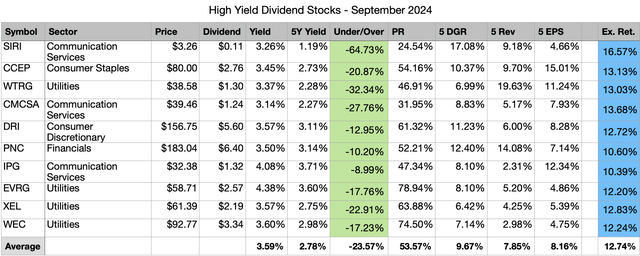
All of the selected stocks this month appear to be potentially undervalued based on dividend yield theory.
The expected rate of return shown in the last column is computed by taking the current dividend yield plus a return to fair value over the next 5 years and a discounted long-term earnings growth forecast.
Please keep in mind that my return forecasts are based on assumptions and should be viewed as such. I am not expecting that these 10 companies will hit the forecasted returns. What I do expect is that these 10 companies have the potential to offer better returns during the next 5 years compared to the 18 high-yield stocks that passed my initial filters but ranked worse in quality and valuation.
Past Performance
The strong beat on both benchmarks in July extended into August with the watchlist delivering another 5%+ return during the month. Year-to-date the watchlist continues to outpace VYM and has now slid ahead of SPY. Since inception, which was 46 months ago, the watchlist has an annualized rate of return of 18.64%, placing it 2.09% ahead of VYM and 1.65% ahead of SPY. The strong return in August sees the long-term alpha improve relative to both benchmarks.
I do not expect that this watchlist will beat VYM or SPY every month. However, I believe that a buy-and-hold investing approach leveraging the stocks presented on this watchlist will generate long-term alpha compared to the broad market. I also have a personal target rate of return of 12% that, I believe, will be attained by this watchlist when measured over long periods of time. Thus far, the watchlist is performing adequately and remains ahead of target.
In the table below, you can see that the watchlist has performed rather well recently, with the 3 and 6-month returns all being significantly better than those for VYM and marginally better than SPY.
|
Date |
Top 10 List |
ALL |
VYM |
SPY |
|
1 month |
5.45% |
3.16% |
2.44% |
2.34% |
|
3 month |
9.42% |
9.23% |
7.04% |
7.23% |
|
6 month |
21.60% |
14.32% |
11.91% |
11.66% |
|
2020 |
16.44% |
16.44% |
16.09% |
14.99% |
|
2021 |
26.31% |
27.91% |
26.21% |
28.76% |
|
2022 |
-11.95% |
-4.25% |
-0.45% |
-18.16% |
|
2023 |
22.07% |
9.56% |
6.58% |
26.18% |
|
2024 |
21.82% |
14.45% |
15.70% |
19.35% |
|
Since Inception |
92.55% |
78.80% |
79.85% |
82.49% |
|
Annualized |
18.64% |
16.37% |
16.55% |
16.99% |
Individual watchlist returns for August 2024 were:
- Coca-Cola Europacific (CCEP) +9.11%
- Comcast (CMCSA) -4.12%
- Darden Restaurants (DRI) +8.11%
- Evergy (EVRG) +3.10%
- NextEra Energy +6.07%
- Starbucks +22.05%
- Sirius XM Holdings (SIRI) -3.83%
- United Parcel Service -0.15%
- WEC Energy (WEC) +9.11%
- Essential Utilities +5.06%
Top 5 performing past and present watchlist stocks in August 2024:
- Kellanova (K) +38.62%
- Starbucks +22.05%
- Clorox (CLX) +21.01%
- Progressive (PGR) +17.78%
- Best Buy (BBY) +16.04%
Top 5 Stocks by total return since joining the watchlist:
- Broadcom (AVGO) +287.95% (40 months)
- Progressive +198.21% (43 months)
- JPMorgan (JPM) +154.16% (46 months)
- General Dynamics (GD) +148.58% (46 months)
- Principal Financial Group (PFG) +137.92% (46 months)
Top 5 Stocks by Average Monthly return since joining the watchlist:
- Interpublic Group of Companies +5.88% (2 months)
- Starbucks +5.85% (3 months)
- CRH plc (CRH) +4.52% (9 months)
- Discover Financial Services (DFS) +3.88% (12 months)
- Broadcom +3.45% (40 months)
In total, there have been 88 unique high-yield dividend stocks that have appeared in the top 10 list during the past 46 months. Out of these 88 unique stocks, 79 have a positive total return since first appearing on the top 10 list. The average total return for these 79 stocks is 51.03%. The average loss for the 9 stocks that have negative total returns is -31.09%.
Another way to measure the effectiveness of this strategy is by running a dollar cost average buy-and-hold test. In this test, I simulate the investment return of dollar cost averaging an equal sum of money into each of the chosen stocks every month, these positions are then left alone and held forever.
Out of the 88 stocks on this watchlist 78 would have led to a positive overall return under this test. That’s an 88.64% rate of success.
Out of the 25 stocks that have appeared on this watchlist at least 10 times, 23 would have led to positive returns, which is a 92% rate of success.
Here are all 88 stocks, their total return since inception, and the number of months since they first appeared in the top 10 list.
*Note that PXD was acquired by XOM during May of 2024, its return is shown for the period of its addition to this watchlist through month-end April 2024.
|
Symbol |
Since Inception |
Count |
|
AVGO |
287.95% |
40 |
|
PGR |
198.21% |
43 |
|
JPM |
154.16% |
46 |
|
GD |
148.58% |
46 |
|
PFG |
137.92% |
46 |
|
BK |
121.10% |
46 |
|
FDX |
109.00% |
23 |
|
RY |
95.81% |
46 |
|
CM |
88.40% |
46 |
|
MTB |
88.09% |
46 |
|
MRK |
83.80% |
40 |
|
LMT |
79.94% |
46 |
|
PM |
76.80% |
42 |
|
SO |
75.99% |
46 |
|
AMGN |
74.22% |
46 |
|
HBAN |
71.15% |
46 |
|
K |
69.14% |
42 |
|
STT |
66.84% |
46 |
|
BMO |
65.55% |
46 |
|
PAYX |
65.36% |
43 |
|
CMI |
63.83% |
30 |
|
GS |
63.19% |
15 |
|
EPD |
62.44% |
37 |
|
OKE |
59.75% |
17 |
|
TD |
59.46% |
46 |
|
SRE |
58.68% |
42 |
|
DFS |
57.88% |
12 |
|
CSCO |
57.83% |
46 |
|
ATO |
55.39% |
33 |
|
BLK |
53.70% |
28 |
|
TRP |
49.18% |
46 |
|
TXN |
49.06% |
26 |
|
CRH |
48.83% |
9 |
|
SNA |
46.42% |
31 |
|
PXD |
44.84% |
14 |
|
PEP |
44.13% |
46 |
|
BNS |
43.97% |
46 |
|
HD |
42.52% |
26 |
|
USB |
41.94% |
46 |
|
FAST |
41.83% |
19 |
|
CMS |
39.72% |
42 |
|
UL |
36.77% |
18 |
|
SWKS |
35.39% |
23 |
|
DTE |
34.68% |
46 |
|
GIS |
32.46% |
37 |
|
BAC |
31.11% |
13 |
|
NTRS |
31.10% |
46 |
|
CPB |
30.91% |
35 |
|
GLW |
30.60% |
18 |
|
TFC |
27.84% |
46 |
|
EVRG |
25.73% |
46 |
|
PNC |
25.36% |
18 |
|
NEE |
24.25% |
12 |
|
KMB |
24.20% |
43 |
|
DLR |
24.12% |
30 |
|
BX |
22.70% |
29 |
|
CCEP |
21.91% |
8 |
|
EOG |
21.45% |
18 |
|
VZ |
20.92% |
21 |
|
APD |
20.88% |
6 |
|
DRI |
20.15% |
37 |
|
MS |
20.03% |
37 |
|
QSR |
19.85% |
36 |
|
LNT |
18.95% |
46 |
|
MDT |
18.93% |
21 |
|
SBUX |
18.60% |
3 |
|
XEL |
16.58% |
42 |
|
CMCSA |
16.04% |
24 |
|
WEC |
14.65% |
44 |
|
SIRI |
13.83% |
4 |
|
CVS |
13.78% |
46 |
|
XOM |
13.23% |
17 |
|
RCI |
12.37% |
46 |
|
IPG |
12.11% |
2 |
|
AMT |
11.42% |
23 |
|
BBY |
10.91% |
32 |
|
WTRG |
7.01% |
8 |
|
HSY |
4.14% |
6 |
|
CLX |
3.66% |
36 |
|
MMM |
-0.28% |
46 |
|
HAS |
-4.05% |
46 |
|
CMA |
-7.21% |
41 |
|
TROW |
-23.57% |
31 |
|
BEN |
-32.07% |
32 |
|
UPS |
-32.59% |
30 |
|
INTC |
-44.23% |
46 |
|
PARA |
-59.50% |
46 |
|
AAP |
-76.29% |
30 |
Closer Look At New Stock
Here’s a closer look at the new stocks this month: Interpublic Group of Companies, PNC Financial Services, and Essential Utilities.
*Please note that the data shown in the table earlier came from Charles Schwab, while the data shown in the charts below came from Seeking Alpha. Hence, there are some discrepancies.
Let’s start with the 7-year dividend yield theory chart for IPG.
Created by Author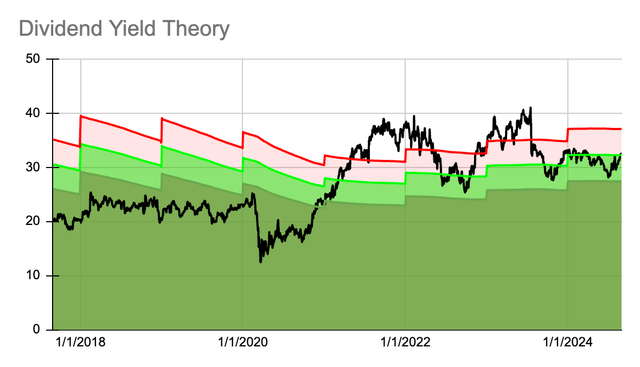
Here is the historical dividend yield.
Created by Author
And its dividend growth history.
| Year | Dividend | Growth | CAGR |
| 2024 | 1.32 | 6.45% | |
| 2023 | 1.24 | 6.90% | 6.45% |
| 2022 | 1.16 | 7.41% | 6.67% |
| 2021 | 1.08 | 5.88% | 6.92% |
| 2020 | 1.02 | 8.51% | 6.66% |
| 2019 | 0.94 | 11.90% | 7.03% |
| 2018 | 0.84 | 16.67% | 7.82% |
| 2017 | 0.72 | 20.00% | 9.05% |
| 2016 | 0.60 | 25.00% | 10.36% |
| 2015 | 0.48 | 26.32% | 11.90% |
| 2014 | 0.38 | 26.67% | 13.26% |
| 2013 | 0.30 | 25.00% | 14.42% |
| 2012 | 0.24 | 15.26% |
Here is the 7-year dividend yield theory chart for PNC.
Created by Author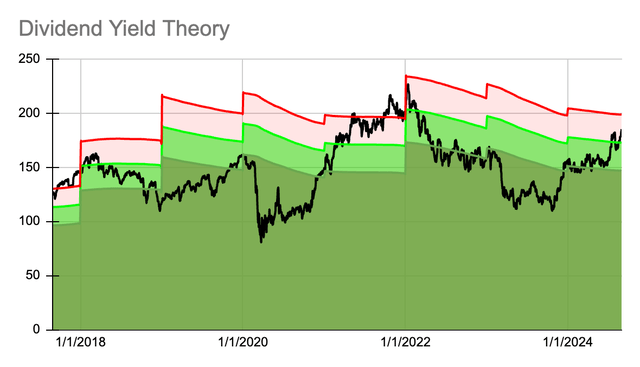
Here is the historical dividend yield.
Created by Author
And its dividend growth history.
| Year | Dividend | Growth | CAGR |
| 2024 | 6.30 | 3.28% | |
| 2023 | 6.10 | 6.09% | 3.28% |
| 2022 | 5.75 | 19.79% | 4.67% |
| 2021 | 4.80 | 4.35% | 9.49% |
| 2020 | 4.60 | 9.52% | 8.18% |
| 2019 | 4.20 | 23.53% | 8.45% |
| 2018 | 3.40 | 30.77% | 10.83% |
| 2017 | 2.60 | 22.64% | 13.48% |
| 2016 | 2.12 | 5.47% | 14.58% |
| 2015 | 2.01 | 6.91% | 13.53% |
| 2014 | 1.88 | 9.30% | 12.85% |
| 2013 | 1.72 | 10.97% | 12.53% |
| 2012 | 1.55 | 12.40% |
Here is the 7-year dividend yield theory chart for WTRG.
Created by Author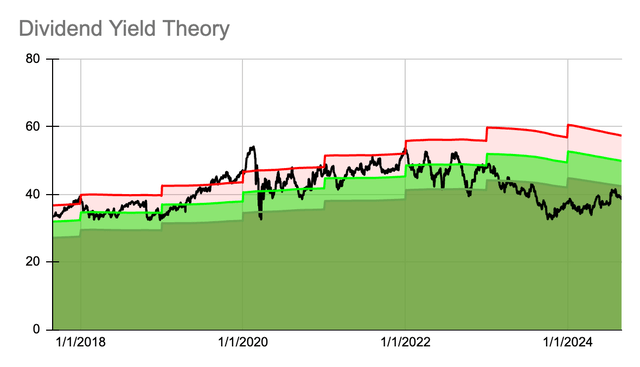
Here is the historical dividend yield.
Created by Author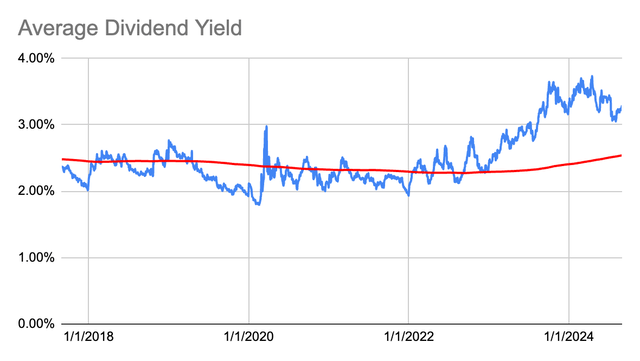
And its dividend growth history.
| Year | Dividend | Growth | CAGR |
| 2024 | 1.27 | 6.48% | |
| 2023 | 1.19 | 7.01% | 6.48% |
| 2022 | 1.11 | 7.00% | 6.74% |
| 2021 | 1.04 | 6.99% | 6.83% |
| 2020 | 0.97 | 6.99% | 6.87% |
| 2019 | 0.91 | 6.99% | 6.89% |
| 2018 | 0.85 | 6.99% | 6.91% |
| 2017 | 0.79 | 7.23% | 6.92% |
| 2016 | 0.74 | 7.67% | 6.96% |
| 2015 | 0.69 | 8.20% | 7.04% |
| 2014 | 0.63 | 8.56% | 7.15% |
| 2013 | 0.58 | 8.96% | 7.28% |
| 2012 | 0.54 | 7.42% |
